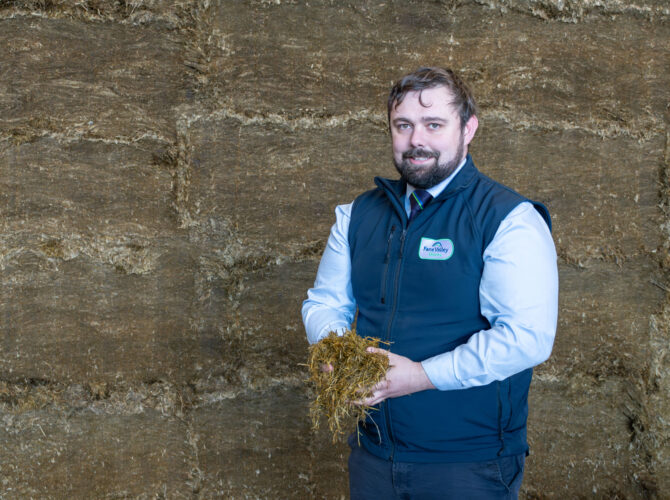Making Quality Silage
11th April 2024

Grass maturity has the largest impact on the feeding value of grass silage. Heading date and cutting date are the two factors which most influence grass maturity. As the grass starts to bulk up and yield increases, quality declines as the grass naturally begins to produce stems and heads. These are less digestible than leaf. Optimum cutting date will be determined by target silage D-value which is influenced by the class of stock the silage will be fed to. As a rule, D-value (digestibility) falls by 0.5 units a day from when the grass starts to push up flowering stems (this is before seed heads are visible).
For farmers wishing to maximise production, a multi-cut silage system should be considered. In this system grass is cut regularly with 4 or more cuts taken in a year. The aim is to cut the grass every 28-35 days to maximise the energy and protein of the grass. These high-quality forages reduce the need for more expensive high protein concentrates. To achieve this quality of grass it must be cut before the stem begins to develop, although this will result in lower fresh weight yields for each cut, the regrowth will be much faster and total yields across the season will be similar, if not better.
This spring is proving very difficult to get field work completed. Slurry and fertiliser applications have been delayed and, on some ground, it has not been possible to get slurry applied. This leads to a need to adapt plans from normal to ensure quality silage can still be produced. Where no slurry has been applied, grass is likely to be too strong for application, without contamination of the leaf. This shortfall in nutrients may require a compound fertiliser to replace the phosphorus and potassium which should have been supplied through slurry. It is also important to adjust the rate of nitrogen being applied, perennial ryegrass uptakes approximately 2 units of nitrogen (2.5kg/ha) per day. The level of nitrogen required can be calculated by counting the number of days until the target cutting date and multiplying by 2 for the number of units per acre or 2.5 for the kg/ha. If you are targeting to cut on the 15th May and will be applying your fertiliser application on the 15th of April, you should therefore only apply 60 units of nitrogen. As part of our Forage Improvement programme we can provide the advice required to make these decisions on a farm-by-farm and field-by-field basis.
A precut test should be carried out to ensure that all nitrates have been used in the grass and it is suitable for ensiling. If nitrates are too high it will inhibit fermentation, low sugar also leaves fermentation difficult and soil/slurry contamination should be avoided at all costs. With challenging conditions, a quality silage additive such as the Magniva or Pioneer range of grass silage additives should be applied. These additives have high counts of homofermentative bacteria to drive fermentation with specific additives in the range also containing heterofermentative bacteria to prevent the growth of yeasts and moulds at feed out. The Magniva range and Pioneer 11G22 contain enzymes will help release sugar in the grass and aid with fermentation, this is particularly important when grass sugar levels are low.
When it comes to harvesting the grass, mow when the dew has dried off. Plants will contain higher sugar levels later in the day but there is a reduced opportunity for wilting. A rapid wilt concentrates the sugars, helping achieve a quick and effective fermentation. Ideally the crop should be harvested between 24-36 hours after mowing. When mowing mowers should be set to leave a stubble of at least 5cm (7-8cm if multi-cut or red clover swards) this allows air movement beneath the lying grass and prevents soil and slurry being mixed with the grass. If tedding and or raking, ensure machines are set correctly so they efficiently pick up the grass but do not touch the soil surface as again this will mix soil and slurry with the grass.
When harvesting grass chop length is important to allow good consolidation but also to prevent slippage in wet and leafy grass. Chop length will be dependent on dry matter, wetter silages need to be chopped longer than drier grass. If dry matter is greater than 30%, target chop length will be 2.5cm however if between 20-30% it should be chopped to 2.5-5cm.
To find out more about making the best quality silage for your needs and to benefit from the Forage Improvement Programme speak to a member of the Fane Valley Agronomy & Forage team or call 02892610485.

